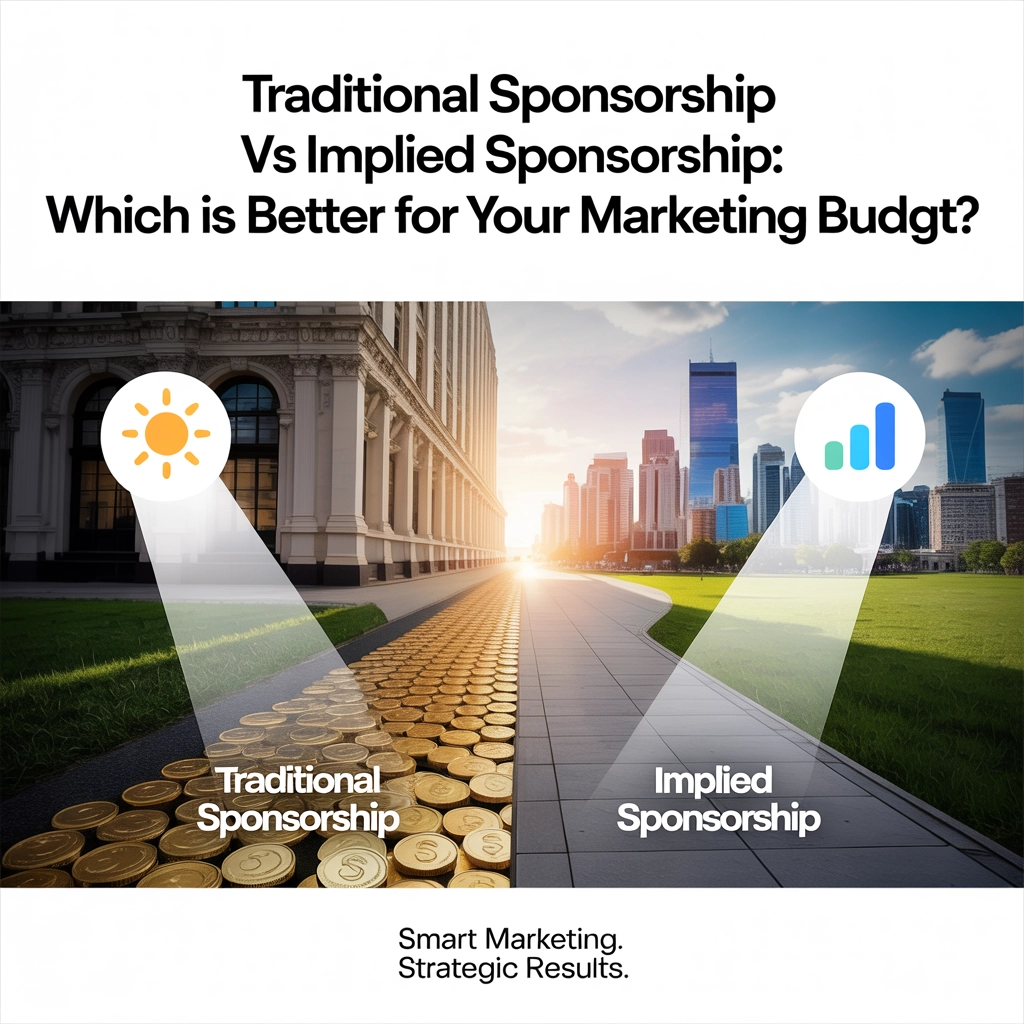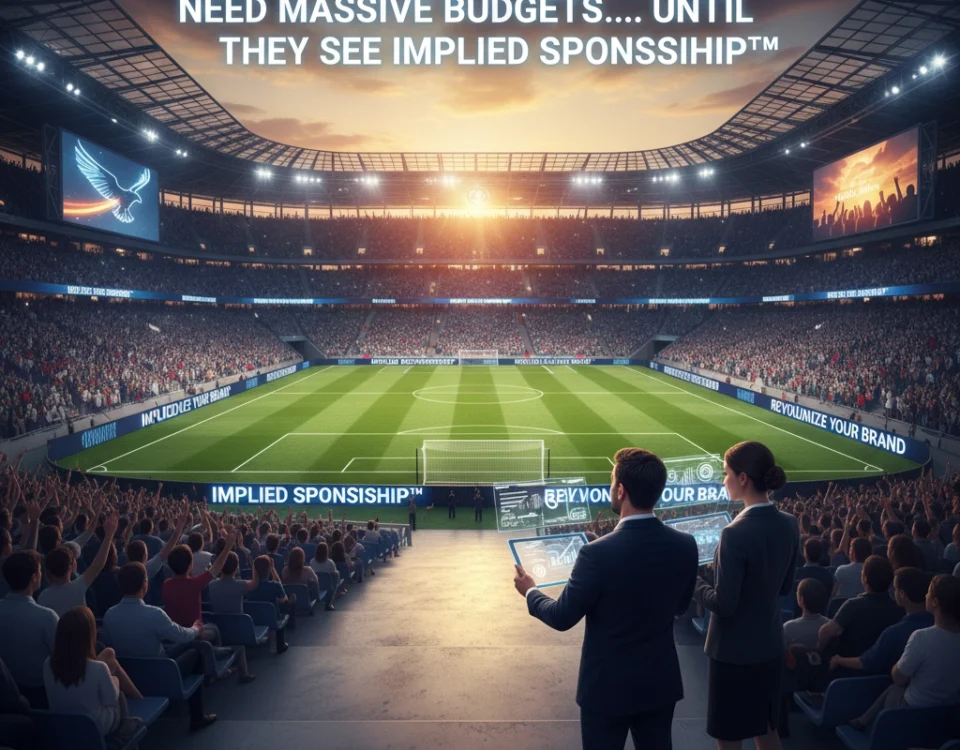
Struggling With Sports Marketing ROI? 50+ Measurable Activation Examples That Actually Work
March 1, 2025
Are You Missing Out on Women's Sports? Here's What Smart Brands Are Doing Right Now
May 1, 2025Traditional Sponsorship Vs Implied Sponsorship: Which Is Better For Your Marketing Budget?

4418f20d 1e63 490d 8560 f13e5c865b64 hero picture

How would you like to look like a Super Bowl Sponsor for $100k instead of $4 million? The answer lies in understanding the revolutionary difference between traditional sponsorship and Implied Sponsorship.
Traditional sponsorship burns through marketing budgets faster than you can say "logo placement." Implied Sponsorship delivers mass appeal without the mass expense. Which approach generates more brand loyal fans for your investment?
What Is Traditional Sponsorship?
Traditional sponsorship represents the old-school approach to sports marketing. Companies write massive checks to slap their logos on jerseys, stadiums, and broadcast graphics. This method demands enormous upfront investments with limited creative control.
Traditional Sponsorship Characteristics:
- Explicit logo placement on uniforms and venues
- High-cost entry barriers starting at millions for major events
- Rigid contractual limitations on creative execution
- Shared attention with dozens of other sponsors
- Limited audience engagement beyond passive logo exposure
Traditional sponsors compete for attention in cluttered visual environments. Your brand becomes one logo among hundreds, fighting for recognition in a sea of corporate messaging.

Implied Sponsorship: The Game-Changing Alternative
Implied Sponsorship revolutionizes how brands connect with sports audiences. This innovative approach creates authentic associations without traditional sponsorship costs. Implied Sponsorship builds brand loyal fans through strategic content partnerships and targeted activations.
Implied Sponsorship Advantages:
- Cost-effective implementation at 10-20% of traditional sponsorship costs
- Creative freedom to develop unique brand experiences
- Exclusive positioning without competitor interference
- Authentic audience connections through valuable content
- Measurable ROI with direct response capabilities
How does Implied Sponsorship work? It leverages strategic partnerships, content marketing, and digital activations to create sponsorship-level brand associations. Your brand gains mass appeal without mass investment.
The Budget Reality Check
Traditional sponsorship demands budgets that most companies simply cannot afford. Super Bowl sponsorships cost $4-7 million for 30 seconds of exposure. Stadium naming rights require $100+ million over 20-year terms. Title sponsorships for major events start at $10 million annually.
Traditional Sponsorship Budget Requirements:
- Major League sponsorships: $5-50 million annually
- Stadium naming rights: $100-400 million over contract terms
- Title event sponsorships: $10-25 million per event
- Jersey sponsorships: $20-60 million for premier teams
- Broadcast sponsorships: $1-5 million per campaign
These astronomical costs eliminate 99% of potential sponsors from major sports marketing opportunities.
Implied Sponsorship Budget Efficiency
Implied Sponsorship delivers sponsorship-level impact at advertising-level investment. Companies achieve mass appeal and brand loyal fans for 90% less than traditional sponsorship costs.
Implied Sponsorship Investment Levels:
- Digital campaigns: $50,000-$200,000 for major reach
- Content partnerships: $25,000-$100,000 per activation
- Influencer collaborations: $10,000-$75,000 per campaign
- Event activations: $30,000-$150,000 per experience
- Social media integrations: $15,000-$60,000 per platform

ROI Comparison: Traditional vs Implied Sponsorship
Which approach generates superior return on investment? The numbers reveal a clear winner.
Traditional Sponsorship ROI Challenges:
- Difficult attribution of brand lift to specific sponsorships
- Long-term contracts with limited flexibility
- Passive exposure without direct response mechanisms
- Shared messaging dilutes individual brand impact
- High costs require massive scale to justify investment
Implied Sponsorship ROI Advantages:
- Direct response tracking measures immediate impact
- Flexible campaigns adapt to performance data
- Active engagement drives meaningful brand interactions
- Exclusive positioning maximizes message effectiveness
- Lower investment achieves profitability faster
Companies using Implied Sponsorship report 3-5x better cost-per-acquisition compared to traditional sponsorship approaches. Brand loyal fans develop through authentic connections rather than passive logo exposure.
Audience Engagement: Quality vs Quantity
Traditional sponsorship focuses on reach numbers. Implied Sponsorship prioritizes engagement quality. Which approach builds stronger brand loyal fans?
Traditional Sponsorship Audience Limitations:
- Passive consumption of logo-heavy content
- Banner blindness reduces sponsor recognition
- Cluttered environments compete for attention
- Limited interaction opportunities with audiences
- Generic messaging lacks personalization capabilities
Implied Sponsorship Engagement Excellence:
- Interactive experiences encourage active participation
- Personalized content resonates with target audiences
- Direct communication builds authentic relationships
- Valuable information positions brands as helpful resources
- Community building creates long-term brand advocacy

Creative Freedom: Constraints vs Opportunities
Traditional sponsorship operates within rigid guidelines. Implied Sponsorship unleashes creative potential to develop innovative brand experiences.
Traditional sponsors must conform to existing event aesthetics, messaging restrictions, and competitor considerations. Your creative team works within someone else's vision.
Implied Sponsorship grants complete creative control. Develop unique brand experiences that align perfectly with your marketing objectives. Create content that resonates specifically with your target audience without external limitations.
Market Differentiation Strategies
How do you stand out in crowded traditional sponsorship environments? You don't. Every sponsor competes for the same attention using similar tactics.
Implied Sponsorship creates exclusive positioning opportunities. Your brand owns the conversation around specific sports topics, events, or personalities. Develop thought leadership that establishes market authority.
Implied Sponsorship Differentiation Tactics:
- Exclusive content partnerships with sports personalities
- Proprietary data insights shared with target audiences
- Behind-the-scenes access unavailable through traditional channels
- Interactive technology enhances fan experiences
- Community-driven initiatives build grassroots support
Implementation Timeline Comparison
Traditional sponsorship requires 12-24 month lead times for major opportunities. Contract negotiations, approval processes, and production timelines extend campaign launches significantly.
Implied Sponsorship campaigns launch within 30-90 days. Agile implementation allows rapid response to market opportunities and performance optimization.
Traditional Sponsorship Timeline Challenges:
- Contract negotiations: 3-6 months
- Creative development: 2-4 months
- Production requirements: 2-3 months
- Approval processes: 1-2 months
- Launch coordination: 1 month
Implied Sponsorship Speed Advantages:
- Strategy development: 2-4 weeks
- Content creation: 2-6 weeks
- Platform setup: 1-2 weeks
- Campaign launch: 1 week
- Optimization cycles: Ongoing weekly adjustments

Measuring Success: Metrics That Matter
Traditional sponsorship relies on impressions, reach, and brand lift studies. These metrics provide limited actionable insights for campaign optimization.
Implied Sponsorship delivers comprehensive performance analytics. Track engagement rates, conversion metrics, audience demographics, and direct response results in real-time.
Implied Sponsorship Measurement Capabilities:
- Click-through rates on branded content
- Engagement time with interactive experiences
- Lead generation through content downloads
- Social sharing amplifies organic reach
- Sales attribution connects campaigns to revenue
The Verdict: Which Approach Wins?
Implied Sponsorship delivers superior ROI, creative freedom, and audience engagement compared to traditional sponsorship. Companies achieve mass appeal without mass investment while building authentic brand loyal fans.
Traditional sponsorship serves established brands with unlimited budgets seeking maximum reach. Most companies benefit more from Implied Sponsorship's cost-effective, results-driven approach.
Ready to explore how Implied Sponsorship can revolutionize your sports marketing strategy? Discover the complete Implied Sponsorship guide and learn how to achieve sponsorship-level impact at advertising-level investment.
Transform your marketing budget from expense to profit center with Implied Sponsorship strategies that actually work. The opportunity exists today – will you seize it?

